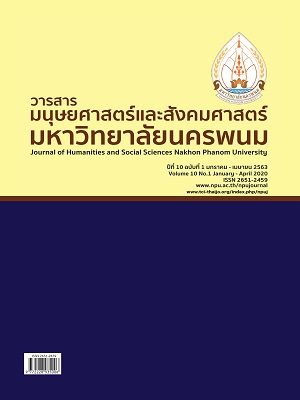Organizational Climate Affecting The Professional Learning Communities of Teacher in Schools the Office of Roi Et Primary Educational Service Area 2
Main Article Content
Abstract
The purpose of this research were 1) study the organization climate of school; 2) study the Professional Learning Communities of Teacher; and 3) study Organizational Climate Affecting Professional Learning Communities of Teacher in the Office of Roi Et Primary Educational Service Area 2. The samples were of 37 school administrators and 317 teachers in the Office of Roi-Et Primary Educational Service Area 2. The research instrument used for collecting the data was a five–point rating scale questionnaire. The statistical methods employed included frequency, percentage, mean, standard deviation and stepwise multiple regression.
The research results were as follows: 1) The Organizational Climate in the Office of Roi Et Primary Educational Service Area 2 as an overall was at the high level with average = 4.28 and Standard Deviation (S.D.) = 0.47. It was also at the high level for each aspect. 2) The Professional Learning Communities of Teacher in the Office of Roi Et Primary Educational Service Area 2 as an overall was at the high level with average = 4.17 and Deviation (S.D.) = 0.55. It was also at the high level for each aspect. 3) Forecasting equation of organizational climate affecting professional learning communities of teachers in educational institutions Under the Office of Roi Et Primary Educational Service Area 2, it was found that the Organization Risk (X4) was the best predictor of the Professional Learning Communities of Teacher followed by the Environment (X5), the Performance Standard (X3), and the Organization Structure (X1), respectively. These predictors could mutually explain the variance of the Professional Learning Communities of Teacher in the Office of Roi Et Primary Educational Service Area 2 for 75.1 percent with the statistical significance at .01 level. The predictive regression equations were as follows.
Raw score regression equation:
= -0.006 +.312X4 + .341X5 +.209X3 + .121X1
Standard score regression equation:
= .312zx433 +.304zx5+ .230zx3 +.116zx1
Article Details
References
ชูชาติ สุทธะ. (2561). กระบวนการพัฒนาชีวิตเชิงพุทธบูรณาการ,วารสารสันติศึกษาปริทรรศน์ มจร. 6(1): 321-331.
ทินกร คลังจินดา. (2557). บรรยากาศองค์การที่ส่งผลต่อประสิทธิผลของโรงเรียน สังกัดสำนักงานเขตพื้นที่การศึกษาประถมศึกษาขอนแก่น เขต 5. วิทยานิพนธ์ ศษ.ม. (การบริหารการศึกษา). มหาวิทยาลัยขอนแก่น.
นริศ ภูอาราม. (2560). การพัฒนาระบบการจัดการเรียนรู้โดยใช้ชุมชนแห่งการเรียนรู้ทางวิชาชีพสำหรับเครือข่ายโรงเรียนประถมศึกษาขนาดเล็ก. วิทยานิพนธ์ กศ.ด. (การบริหารและพัฒนาการศึกษา). มหาวิทยาลัยมหาสารคาม.
เมธาพร เชื้อหอม. (2559). บรรยากาศองค์การในโรงเรียนที่ส่งผลต่อคุณภาพชีวิตการทำงานของข้าราชการครู สังกัดสำนักงานเขตพื้นที่การศึกษาประถมศึกษาฉะเชิงเทรา เขต 1, วารสารราชนครินทร์. 13(30): 99 – 10.
วรวิทย์ พรหมคชและคณะ. (2561) แนวทางการขับเคลื่อน PLC สู่การพัฒนาคุณภาพผู้เรียน Thailand 4.0 สพม.17.ตราด: สำนักงานเขตพื้นที่การศึกษามัธยมศึกษา เขต ๑๗.
วิจารณ์ พานิช. (2555). ครูแห่งศตวรรษที่ 21 ต้องช่วยแก้ไขความรู้ผิดๆ ของนักเรียน. กรุงเทพฯ: สถาบันส่งเสริมการจัดการความรู้เพื่อสังคม.
ศิริรัตน์ โกศล. (2559). การพัฒนาสถานศึกษาโดยใช้แนวคิดชุมชนการเรียนรู้ทางวิชาชีพเพื่อจัดการเรียนรู้ที่เน้นผู้เรียนเป็นสำคัญสำหรับสถานศึกษาสังกัดสำนักงานเขตพื้นที่การศึกษามัธยมศึกษา เขต 24. วิทยานิพนธ์ กศ.ม. (การบริหารการศึกษา). มหาวิทยาลัยมหาสารคาม.
สมุทร สมปอง. (2558). การพัฒนารูปแบบการสร้างชุมชนการเรียนรู้ทางวิชาชีพครูในโรงเรียนประถมศึกษา: การวิจัยปฏิบัติการแบบมีส่วนร่วม.วิทยานิพนธ์ กศ.ด. (การบริหารการศึกษา). มหาวิทยาลัยมหาสารคาม.
สำนักงานศึกษาธิการจังหวัดร้อยเอ็ด. (2561). แผนปฏิบัติราชการสำนักงานศึกษาธิการจังหวัดร้อยเอ็ด. (ออนไลน์). แหล่งที่มา: http://www.roietpeo.go.th/.
สำนักงานส่งเสริมสังคมแห่งการเรียนรู้และคุณภาพเยาวชน. (2557). รายงานผลการดำเนินงานสำนักงานส่งเสริมสังคมแห่งการเรียนรู้และคุณภาพของเยาวชน 2553-2556. กรุงเทพฯ: ม.ป.ท.
Battersby, S. L., & Verdi, B. (2015). The culture of professional learning communities and connections to improve teacher efficacy and support student learning. Arts Education Policy Review, 116(1): 22-29.
Cronbach, L. J. (1990). Essentials of psychological testing. (5th ed.). New York : Harper Collins Publishers.
Fox, R. S. (1973). School climate improvement : A challenge to the school administrator. Englewood ; Colorado : Phi Delta Kappa.
Freiberg, H. J. (2005). School climate: Measuring, improving and sustaining healthy learning environments. United Kingdom: Routledge.
Hord, S.M. (2004). Learning Together, Leading Together: Changing Schools Through Professional Learning Communities. New York: Teachers College.
Likert, R. (1976). New Patterns of Management. New York : Mc Graw - Hill.
Litwin, G.H., & Stringer, R.A. (1968). Motivation and Organizational Climate. Boston : Division of Research Harvard Business School.
Philip Kolter. (2009). Marketing Management. New York: Peason Prentice Hall.
Vanblaere, B., & Devos, G. (2016). Relating school leadership to perceived professional learning community characteristics: A multilevel analysis. Teaching and Teacher Education, 57: 26-38.
Vangrieken, K., Meredith, C., Packer, T., & Kyndt, E. (2017). Teacher communities as a context for professional development: A systematic review. Teaching and teacher education, 61: 47-59.
Vescio, F., Busani, L., Gras, L. M., Fazio, C., Neri, A., Avellis & Stefanelli, P. (2015). Climate, demographic factors and geographical variations in the incidence of invasive meningococcal disease in Italy. Epidemiology & Infection, 143(8): 1742-1750.
Yamane, T. (1973). Statistics: An Introductory Analysis. (3rd ed.). New York : Harper and Row Publication.

